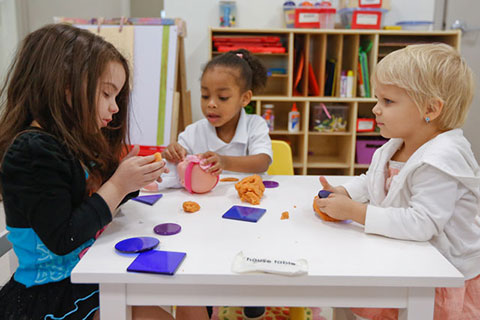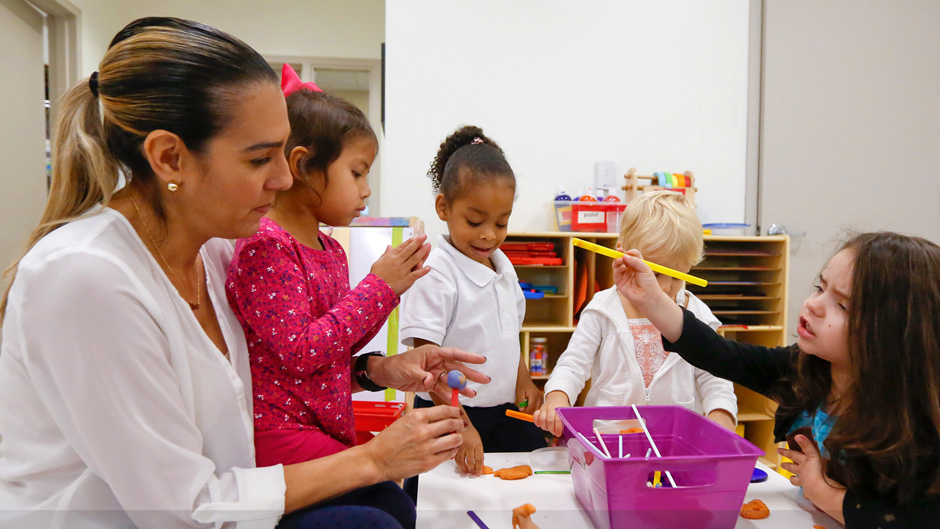Preschoolers Naomi and Samantha sit side by side bouncing their baby dolls around a small wooden table.
“I am making a pie,” Naomi says, picking up some orange Play-Doh and smearing it on the doll’s face. Her classmate mimics her and shapes a round blob from the clay. Then they melt into loud giggles because, after all, that’s what three years old do.
Two friends at play: One of the girls can see, the other is visually impaired. But one cannot tell the difference between them. And that’s the main mission of their school. Housed on the top floors of the Miami Lighthouse for the Blind (MLHB) in Miami’s Little Havana, The Learning Center for Children is a private-public funded initiative that brings together sighted and visually impaired children in the same infant and Pre-K classrooms.
“The goal here is for total immersion,” said Virginia Jacko, CEO of the MLHB and the powerhouse behind the school, which has 40 students. “Blind people hang out with the blind and sighted people do not know how to interact with us.”
And often people assume that blind people are cognitively challenged and cannot make their own decisions, said Jacko.
Blind herself, Jacko wanted a more inclusive academic environment than the traditional one for the visually impaired, so she spearheaded the effort, along with the Miami-Dade County Public Schools and The Children’s Trust, to open the school, which is the only one of its kind in Florida and may be the only one in the nation.
In the clean, colorful classrooms teachers who are certified to teach sighted children and teachers who teach visually impaired children come together with one common purpose. Physical and speech therapists join them as well to provide their services as needed.
Jacko also sought out Rebecca Shearer, University of Miami associate professor in Psychology, who in a partnership with the school and with the help of five graduate UM students conducts research to evaluate the program. The research is the core of a four-year study that will rate how the children develop socially, physically and emotionally, as well as the parents’ well-being.
A clinical psychologist with more than 20 years in studying children in the early childhood environment, Shearer was happy to take part in the innovative venture.
“These students are visually impaired but in terms of their cognitive development they have the capacity to learn and succeed in school like any other child. They just need to access the curriculum in a different way so they can be ready for kindergarten,” she said.
To achieve that goal, classes are small (a 5:1 ratio) and are equipped with braille typewriters and braille markings on everything from colored blocks, books and each toy cabinet. Tables have rounded corners for easy navigating.
The children play and learn side-by-side and openly interact with each other.
 When sighted children learn about colors or objects, the visually impaired are offered tactile alternatives.
When sighted children learn about colors or objects, the visually impaired are offered tactile alternatives.
“When we teach them about the color red, we say red like cherries,” said Tobi Elden, who has taught the visually impaired for over 40 years. “Then we give them cherries so they can taste the color.”
On a recent morning Victor, a visually impaired student, was sitting on the classroom rug building a tower from blocks. Once he finished, he gleefully smashed the tower down and then, encouraged by his teacher, started searching for the blocks by rotating his hands over the rug until he found each block. To put the blocks away, he searched with his fingers and found his teacher’s hands on top of a plastic container where he inserted each one by one. Within seconds he had picked up all the blocks and placed the container in a nearby cubby.
“Our goal is for total independence,” said Isabel Chica, director of children’s programs for MLHB. “They need to know where they are and how they will get to the next place.”
Accolades for the school have been constant, including one from the U.S. House of Representatives. Congresswoman Ileana Ros-Lehtinen congratulated the school from the floor of the House of Representatives.
“I rise to congratulate the Miami Lighthouse for the Blind on its new Height House Learning Center and Pre-K Program,” said Ros-Lehtinen. “The Miami Lighthouse is partnering with the Miami-Dade Public Schools to provide a learning program for Pre-K students…to achieve their potential,” Ros-Lehtinen told her colleagues.
For many of the parents the school has been a blessing. Monica Castro, whose 23- month-old visually impaired daughter Rio is in the infant classroom, said her decision to put her daughter at the Learning Center was a no-brainer.
“It was either there or staying at home,” Castro said. “I feel like she has a special advantage there. They offer a teacher of the visually impaired every day which is unheard of in other schools. It’s a great place.”

